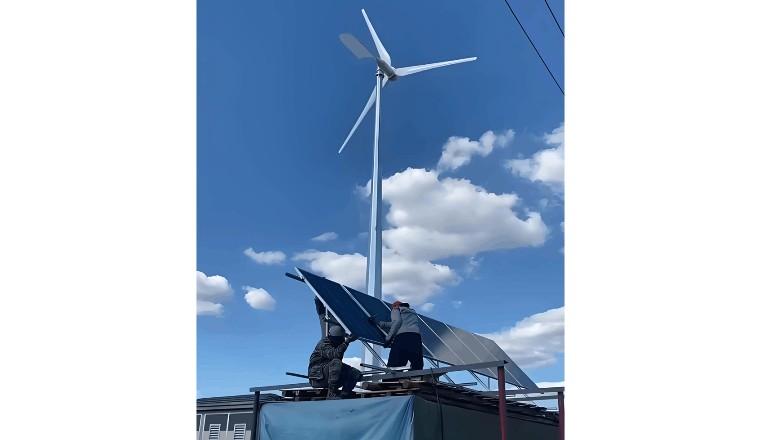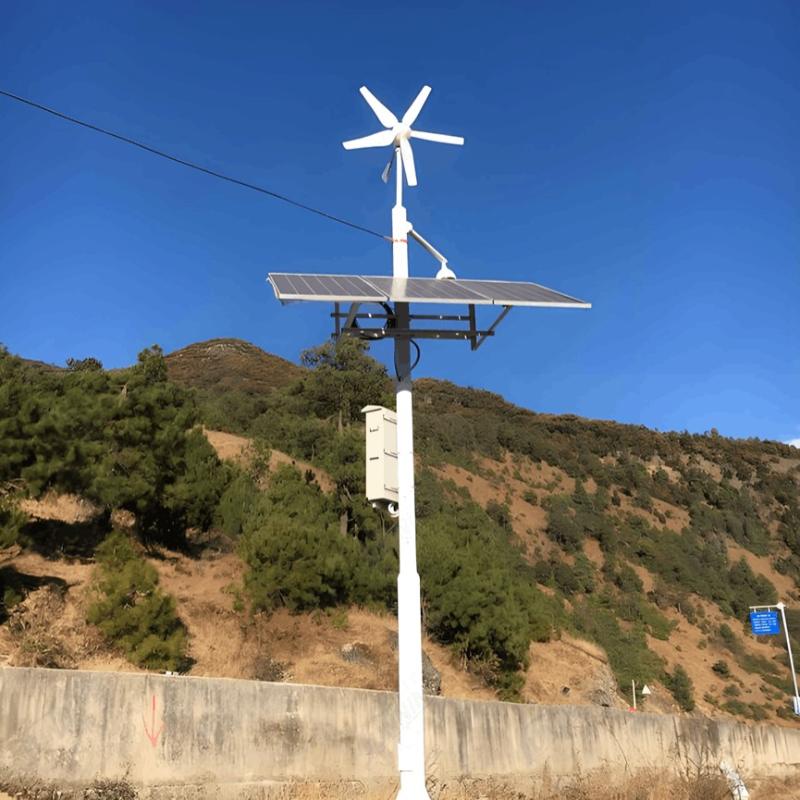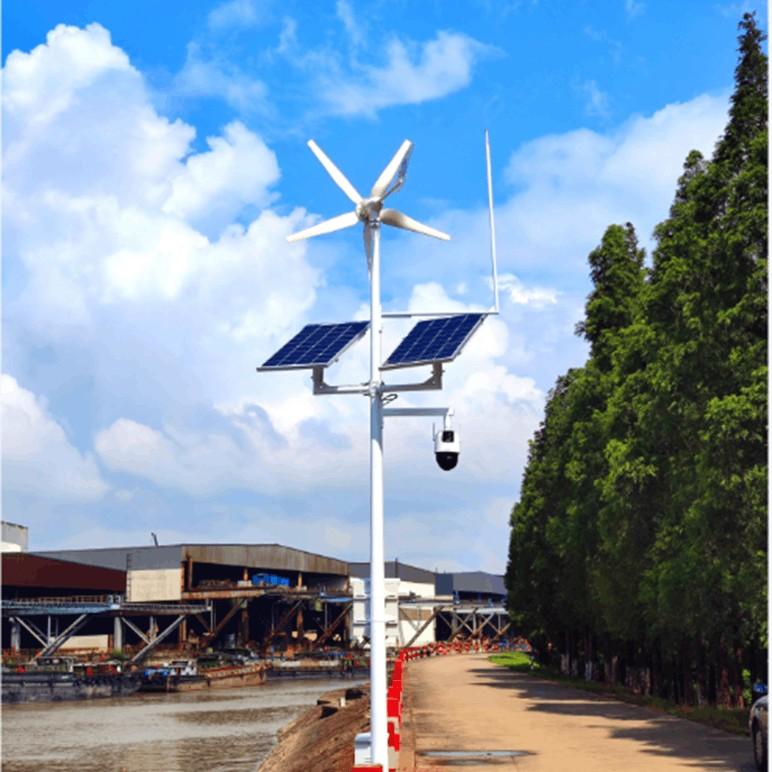1. Analyse des caractéristiques de la production d'énergie éolienne et photovoltaïque solaire
L'analyse des caractéristiques de la production d'énergie éolienne et photovoltaïque (PV) est fondamentale pour la conception d'un système hybride complémentaire. L'analyse statistique des données annuelles de vitesse du vent et d'irradiation solaire pour une région spécifique révèle que les ressources éoliennes présentent une variation saisonnière, avec des vitesses de vent plus élevées en hiver et au printemps et des vitesses plus faibles en été et en automne. La production d'énergie éolienne est proportionnelle au cube de la vitesse du vent, ce qui entraîne des fluctuations significatives de la production.
Les ressources solaires, quant à elles, montrent des modèles clairs diurnes et saisonniers - des journées plus longues et un rayonnement plus fort en été, et des conditions plus faibles en hiver. L'efficacité des panneaux PV est négativement affectée par l'augmentation des températures. En comparant la distribution temporelle de l'énergie éolienne et solaire, il est évident qu'elles présentent un comportement complémentaire sur des cycles quotidiens et annuels. Cette complémentarité permet la conception de systèmes d'énergie efficaces et stables, où un ratio optimal de capacité entre les deux sources d'énergie peut être configuré pour lisser la production d'énergie globale.
2. Modélisation des systèmes de production d'énergie hybrides éolien-solaire
2.1 Modèle du sous-système éolien
Le modèle du sous-système éolien est construit sur les données de vitesse du vent et les caractéristiques des éoliennes. La distribution de Weibull est utilisée pour ajuster la distribution de probabilité de la vitesse du vent, décrivant précisément son comportement statistique. La relation entre la puissance de sortie de l'éolienne et la vitesse du vent est représentée par une fonction par morceaux intégrant des paramètres clés tels que la vitesse de coupure, la vitesse nominale et la vitesse de coupure maximale.
La méthode des moindres carrés est appliquée pour ajuster la courbe de puissance de l'éolienne, donnant une expression mathématique de la puissance de sortie en fonction de la vitesse du vent. Pour tenir compte de la variabilité de la vitesse du vent, la méthode de simulation Monte Carlo est introduite pour prédire la production de l'éolienne. Le modèle reflète avec précision les caractéristiques dynamiques des systèmes éoliens et fournit une base pour l'optimisation du système. Il intègre également l'impact des changements de direction du vent sur l'efficacité de production en introduisant un facteur de correction de la direction du vent, améliorant ainsi la précision de la prédiction.

2.2 Modèle du sous-système photovoltaïque
Le modèle du sous-système photovoltaïque prend en compte de manière exhaustive l'irradiance solaire, la température ambiante et les caractéristiques des modules PV. Un modèle statistique de l'irradiance solaire est établi pour décrire ses variations temporelles. Les caractéristiques de sortie des modules PV sont représentées par des courbes I-V. Les effets de la température sur l'efficacité sont modélisés à l'aide d'un circuit équivalent à un diode unique, avec la puissance de sortie calculée en résolvant un système d'équations non linéaires.
Le modèle inclut également des facteurs tels que l'ombrage et l'accumulation de poussière, introduisant des coefficients de correction pour améliorer la précision de la prédiction. Il prend en compte le vieillissement des modules PV en incorporant un taux de dégradation annuel pour prévoir les changements de puissance de sortie à long terme. Ce modèle reflète avec précision les performances du système PV dans des conditions environnementales variables.
2.3 Modèle du système de stockage d'énergie
Le modèle du système de stockage d'énergie est principalement basé sur les caractéristiques des batteries lithium-ion. Un modèle dynamique de l'état de charge (SOC) de la batterie est développé pour décrire les processus de charge et de décharge. Les caractéristiques d'autodécharge et l'efficacité de charge/décharge sont prises en compte, avec l'introduction d'un facteur de correction de température pour refléter les impacts environnementaux. La durée de vie de la batterie est modélisée en utilisant une combinaison de nombre de cycles et de profondeur de décharge (DOD) pour prédire la dégradation de la capacité.
Le modèle reflète avec précision les performances de la batterie dans différentes conditions de fonctionnement, soutenant des stratégies optimales de dimensionnement et de gestion. Il prend également en compte la variation de la résistance interne en établissant des relations fonctionnelles entre la résistance, le nombre de cycles et la température, permettant une simulation plus précise du comportement dynamique. Les sorties clés incluent le SOC en temps réel, la capacité disponible, la puissance de charge/décharge et la durée de vie attendue - fournissant un support de données complet pour une opération et une maintenance optimales.
2.4 Modèle d'intégration du système
Le modèle intégré du système combine les sous-systèmes éolien, solaire et de stockage dans un cadre unifié. La méthode de charge équivalente est utilisée pour gérer les fluctuations de charge, et une équation d'équilibre de puissance du système est établie. Des indices de fiabilité tels que la Probabilité de Perte de Charge (LOLP) et l'Énergie Non Fournie Attendue (EENS) sont introduits pour évaluer les performances du système. Une simulation séquentielle en série temporelle est utilisée pour calculer les états de fonctionnement du système à différentes échelles de temps.
Le modèle prend en compte les interactions entre les sous-systèmes, telles que l'ombrage des panneaux PV par les éoliennes. Il intègre également une interface réseau, permettant l'analyse des stratégies de fonctionnement connecté au réseau, y compris la dispatch économique selon les tarifs horaires et les services de régulation de fréquence du réseau. Les sorties incluent la production totale d'énergie, le taux de satisfaction de la charge et les indicateurs de performance économique, fournissant une base théorique complète pour la planification, la conception et la prise de décision opérationnelle du système.
3. Méthodes d'optimisation et analyse expérimentale des systèmes hybrides éolien-solaire
3.1 Fonction objectif et contraintes
La fonction objectif d'optimisation intègre des considérations économiques, de fiabilité et environnementales. L'objectif économique vise à minimiser le coût total du système, y compris l'investissement initial, l'exploitation et la maintenance (O&M), et les coûts de remplacement. L'objectif de fiabilité vise à maximiser la fiabilité de l'alimentation en électricité, quantifiée par la minimisation de la LOLP. L'objectif environnemental est mesuré par la maximisation de la réduction des émissions de carbone.
Les contraintes incluent l'équilibre de puissance, les limites de capacité de stockage et les limites opérationnelles des équipements. La contrainte d'équilibre de puissance garantit que la demande de charge est satisfaite en tout temps. Les contraintes de capacité de stockage limitent la profondeur de décharge (DOD) pour prolonger la durée de vie de la batterie. Les contraintes d'équipement prennent en compte la puissance nominale et les caractéristiques opérationnelles des composants. Une méthode de pondération multi-objectif intègre ces objectifs dans une seule fonction objectif, avec des poids déterminés en fonction des préférences des décideurs et des scénarios d'application.
3.2 Application de l'Optimisation par Essaim Particulaire (PSO)
L'Optimisation par Essaim Particulaire (PSO), un algorithme d'optimisation intelligent, est appliquée à la conception des systèmes hybrides éolien-solaire. Simulant le comportement de vol d'oiseaux, le PSO recherche des solutions optimales dans l'espace de solution. Chaque particule représente une configuration potentielle du système, y compris des variables de décision telles que la capacité de l'éolienne, la capacité PV et la capacité de stockage. La position et la vitesse des particules sont mises à jour itérativement, convergeant vers l'optimum global.
Pour améliorer les performances, une stratégie de poids d'inertie linéairement décroissante est adoptée - maintenant une exploration globale forte au début et améliorant l'exploitation locale ultérieurement. La mutation adaptative est introduite pour éviter les optima locaux. Étant donné la complexité du problème, une stratégie de codage hiérarchique sépare les variables continues et discrètes. L'algorithme se termine lorsqu'il atteint le nombre maximum d'itérations ou lorsque la valeur optimale change de moins d'un seuil sur des itérations consécutives.
3.3 Conception expérimentale et paramétrage
L'expérience est basée sur des données météorologiques et de charge réelles d'une région spécifique, utilisant une année typique de données horaires. Les entrées météorologiques comprennent la vitesse du vent, l'irradiance solaire et la température ambiante horaires. Les profils de charge suivent un modèle de consommation typique d'un parc industriel, reflétant les variations saisonnières et diurnes. Les paramètres des équipements sont sélectionnés parmi les éoliennes et les modules PV commerciaux mainstream, avec des données de performance provenant des rapports de test des fabricants.
Une batterie lithium-ion est utilisée pour le stockage, avec des paramètres comprenant la capacité nominale, l'efficacité de charge/décharge et la durée de vie en cycles. Les paramètres PSO sont définis comme suit : taille de la population = 50, nombre maximum d'itérations = 1000, poids d'inertie décroissant linéairement de 0,9 à 0,4, et facteurs d'apprentissage c1 et c2 tous deux fixés à 2. Pour assurer la fiabilité des résultats, chaque configuration est exécutée 30 fois, la moyenne étant prise comme résultat final.
3.4 Métriques d'évaluation des performances du système
Les métriques d'évaluation des performances couvrent les aspects techniques, économiques et environnementaux. Les indicateurs techniques incluent la fiabilité du système, le taux d'utilisation de l'énergie et la stabilisation de la puissance. La fiabilité est mesurée par l'Indice de Capacité de Fourniture Fiable (RSCI) et la Probabilité de Perte de Fourniture d'Énergie (LPSP). Le taux d'utilisation de l'énergie reflète l'efficacité des énergies renouvelables, tandis que la stabilisation de la puissance évalue la stabilité de la production. Les indicateurs économiques incluent le Coût Nivellisé de l'Électricité (LCOE), la Valeur Actuelle Nette (NPV) et la période de récupération. Le LCOE prend en compte les coûts sur le cycle de vie, le NPV reflète la rentabilité du projet, et la période de récupération évalue la vitesse de récupération du capital.
L'indicateur environnemental est la réduction des émissions de carbone, calculée par comparaison avec la production basée sur des combustibles fossiles conventionnels. De plus, un indice de performance composite - l'Indice de Bénéfice Complet du Système (SCBI) - intègre les facteurs techniques, économiques et environnementaux par sommation pondérée. Ces métriques et leurs poids sont déterminés en fonction du jugement d'experts et des besoins pratiques, fournissant une évaluation complète des performances du système et soutenant les décisions éclairées.
| Catégorie |
Nom de l'indicateur |
Symbole |
Unité |
Valeur |
| Indicateurs techniques |
Fiabilité de l'alimentation en électricité |
RSCI |
% |
99,2 |
| Probabilité de perte de l'alimentation en électricité |
LPSP |
% |
0,8 |
| Taux d'utilisation de l'énergie |
EUF |
% |
87,5 |
| Coût de l'alimentation en électricité |
POE |
yuan/kWh |
0,85 |
| Indicateurs économiques |
Coût nivellisé de l'électricité |
LCOE |
yuan/kWh |
0,45 |
| Valeur actuelle nette |
NPV |
dix mille yuan |
1200 |
| Période de récupération |
PBP |
année |
7,5 |
| Indicateurs environnementaux |
Réduction des émissions de carbone |
CER |
t/an |
3500 |
| Indicateurs composites |
Indice de bénéfice composite du système |
SCBI |
— |
0,92 |
3.5 Analyse des résultats d'optimisation
Les résultats d'optimisation démontrent que le système de production d'énergie hybride éolien-solaire offre des avantages significatifs par rapport aux systèmes mono-énergie. Dans le scénario de référence, la configuration optimale comprend 2 MW de capacité éolienne, 1,5 MW de capacité photovoltaïque (PV) et 500 kWh de stockage d'énergie. Cette configuration réduit la Probabilité de Perte de Fourniture d'Énergie (LPSP) à moins de 1% et abaisse le Coût Nivellisé de l'Électricité (LCOE) d'environ 15% par rapport aux systèmes éoliens ou PV indépendants. L'analyse de sensibilité révèle que le coût des équipements a le plus grand impact sur les résultats d'optimisation - une réduction de 10% du coût conduit à une diminution approximative de 8% du LCOE.
Les variations du profil de charge affectent significativement la dimension du stockage d'énergie ; une augmentation des différences de charge pic-valley nécessite une capacité de stockage plus grande. Les configurations optimales varient selon les régions : les zones riches en vent favorisent des ratios plus élevés de puissance éolienne, tandis que les régions ensoleillées augmentent la part de PV. L'optimisation multi-objectif génère un front de Pareto, permettant aux décideurs de trouver un équilibre entre l'efficacité économique et la fiabilité en fonction des besoins pratiques. Les résultats montrent également qu'en incorporant un mécanisme de trading de carbone, on améliore davantage la performance économique, réduisant le LCOE de 5% à 10% supplémentaires. La simulation à long terme confirme la stabilité du système, avec une dégradation des performances sur une période opérationnelle de 20 ans restant dans les tolérances de conception.
| Schéma de configuration |
Capacité éolienne (MW) |
Capacité photovoltaïque (MW) |
Capacité de stockage d'énergie (kWh) |
LPSP (%) |
LCOE (yuan/kWh) |
Faire un don et encourager l'auteur
Tension de fonctionnement minimale pour les disjoncteurs à vide
Tension minimale de fonctionnement pour les opérations de coupure et de fermeture dans les disjoncteurs à vide1. IntroductionLorsque vous entendez le terme "disjoncteur à vide", cela peut sembler peu familier. Mais si nous disons "disjoncteur" ou "interrupteur de puissance", la plupart des gens sauront ce que cela signifie. En fait, les disjoncteurs à vide sont des composants clés des systèmes électriques modernes, responsables de la protection des circuits contre les dommages. Aujourd'hui, expl
Assurer la fiabilité du système hybride avec des tests de production complets
Procédures et méthodes d'essai de production pour les systèmes hybrides éolien-solairePour garantir la fiabilité et la qualité des systèmes hybrides éolien-solaire, plusieurs essais critiques doivent être effectués pendant la production. Les essais des éoliennes comprennent principalement les essais des caractéristiques de sortie, les essais de sécurité électrique et les essais d'adaptabilité environnementale. Les essais des caractéristiques de sortie nécessitent la mesure de la tension, du cour
Systèmes hybrides éolien-solaire Pannes & Solutions
1. Pannes courantes et causes dans les éoliennesEn tant que composant clé des systèmes hybrides éolien-solaire, les éoliennes connaissent principalement des pannes dans trois domaines : la structure mécanique, les systèmes électriques et les fonctions de contrôle. L'usure et la rupture des pales sont les pannes mécaniques les plus courantes, généralement causées par l'impact du vent à long terme, la fatigue des matériaux ou des défauts de fabrication. Les données de surveillance sur le terrain m
Comment le système hybride éolien-solaire peut-il devenir plus intelligent ? Applications pratiques de l'IA dans l'optimisation et le contrôle du système
Contrôle intelligent des systèmes d'énergie renouvelable hybride éolienne-solaire à l'aide de l'intelligence artificielleLes systèmes d'énergie renouvelable hybride éolienne-solaire tirent parti de la durabilité et de la complémentarité des ressources éoliennes et solaires. Cependant, le caractère intermittent et fluctuant de ces sources d'énergie conduit à une production instable, affectant négativement la fiabilité de l'approvisionnement et la qualité de l'énergie. L'optimisation du contrôle d
Obtenir l'application commerciale IEE-Business
Utilisez l'application IEE-Business pour trouver du matériel obtenir des solutions se connecter avec des experts et participer à la collaboration sectorielle en tout lieu et à tout moment soutenant pleinement le développement de vos projets et activités dans le secteur de l'énergie
|























